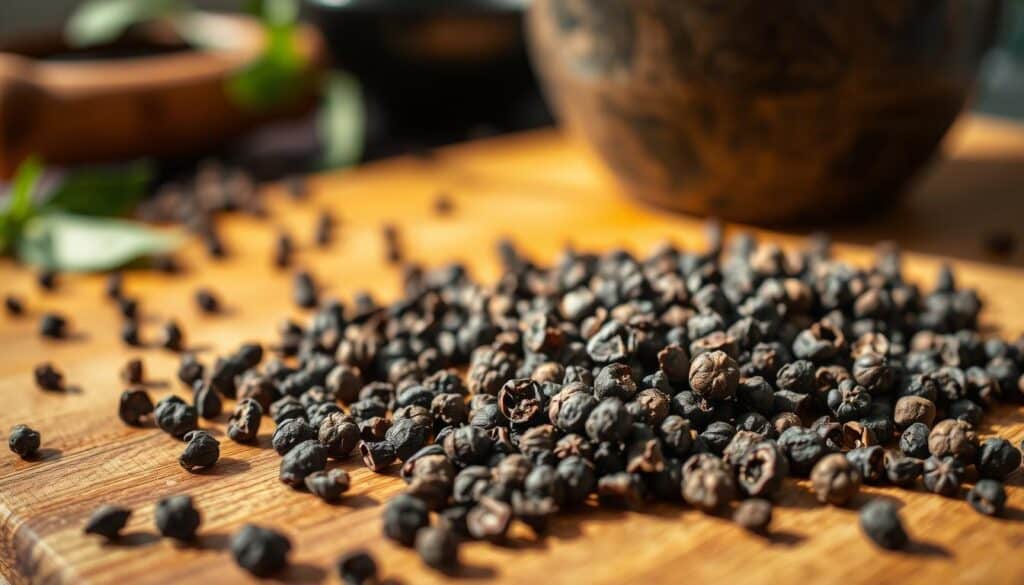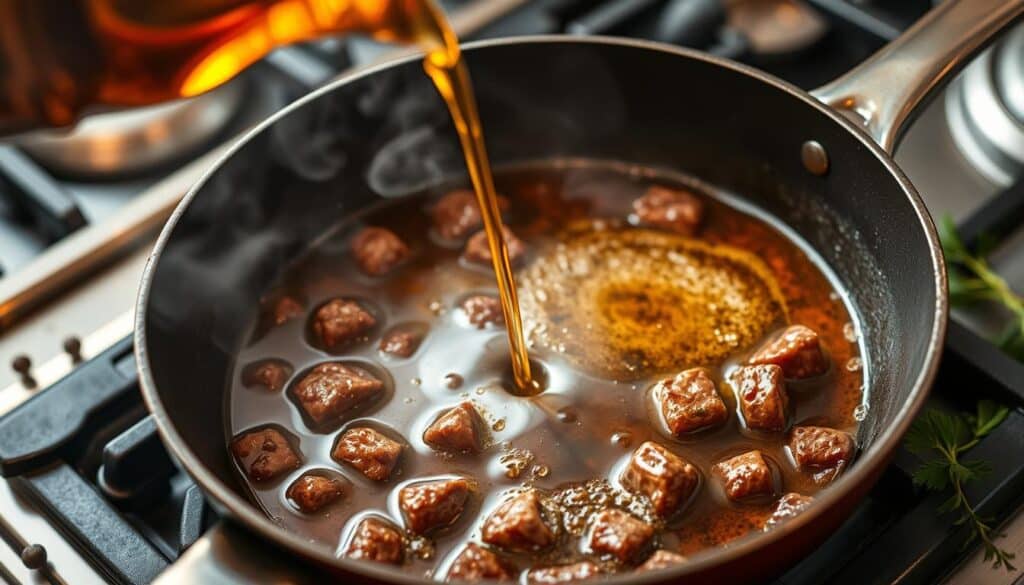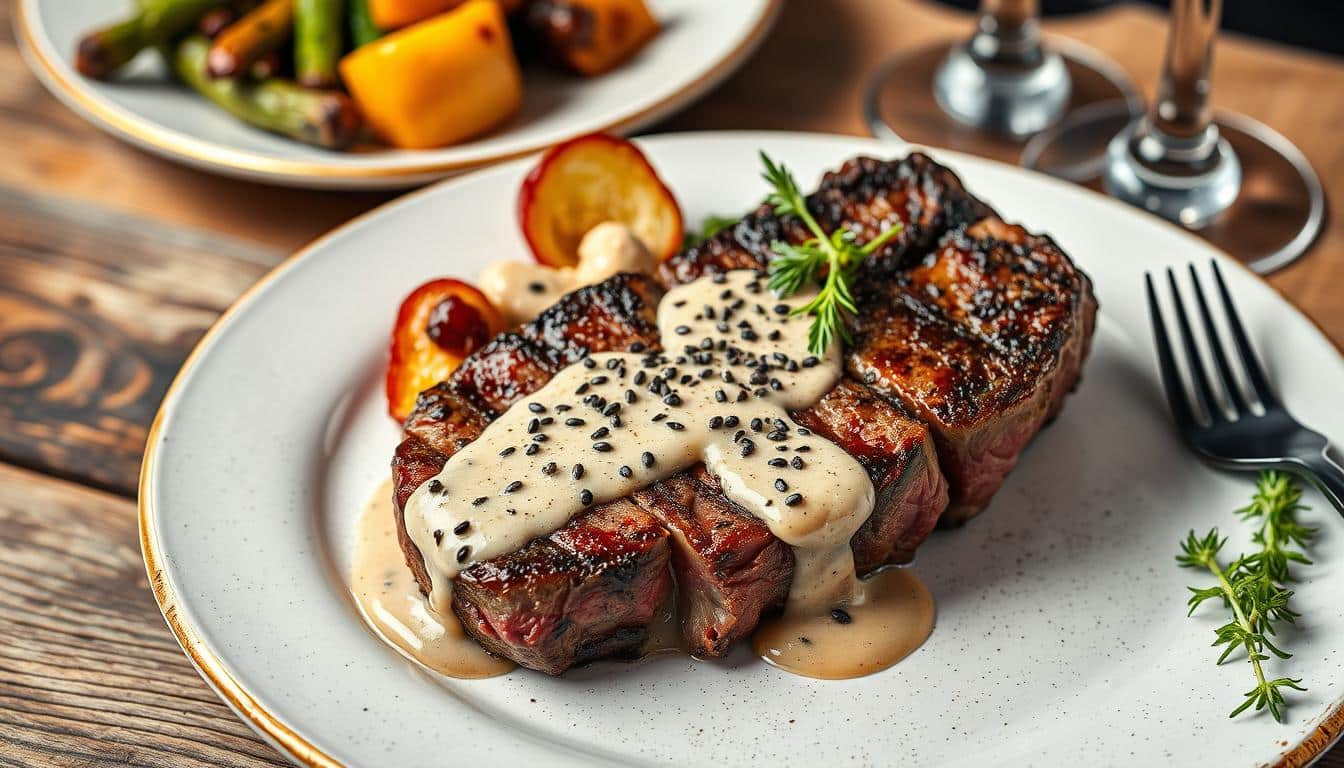We’re exploring French cuisine with a gourmet recipe. Steak au Poivre, or peppercorn steak, is a classic. It combines tender beef with a bold, peppery crust and a luxurious cognac cream sauce.
This elegant meal brings restaurant-quality flavors home. The rich taste of perfectly cooked beef, enhanced by cracked peppercorns and a velvety sauce, is a true culinary delight. Let’s explore how to create this French masterpiece step by step.
Understanding Steak au Poivre (Peppercorn Steak)
Steak au Poivre is a key part of French cuisine. It shows the deep traditions of classic dishes. This steak, covered in crushed peppercorns, has won hearts for many years.For another classic beef recipe, explore our London Broil Recipe.
Origins in French Cuisine
The history of Steak au Poivre goes back to 19th-century Paris. French chefs created this dish, mixing tender beef with a peppercorn crust. It became a hit in bistros and fancy restaurants.
Why This Dish Became a Classic
Steak au Poivre became famous for its great taste. The peppery crust goes well with the beef, and the cream sauce adds luxury. Its simple yet elegant nature makes it a top choice for chefs and home cooks.
Traditional vs Modern Preparations
Old recipes use a thick crust of black peppercorns and a cognac sauce. New versions might include:
- Mixed peppercorn blends for different tastes
- Other cuts like ribeye or sirloin
Even with new twists, Steak au Poivre stays true to its French roots. It celebrates the art of making a perfect pan-seared steak.
Essential Ingredients for the Perfect Peppercorn Steak
To make a delicious peppercorn steak, you need to pick the right ingredients. We’ll show you how to choose the best beef, peppercorns, and sauce. This will make your meal unforgettable.
Selecting the Right Cut of Beef
The beef is the main part of a peppercorn steak. For it to be tender and juicy, use beef tenderloin. This cut is from the loin and is very tender. It has a buttery texture.
When you buy it, look for marbling. Marbling means fat is spread throughout the meat. It makes the steak taste better.

Types of Peppercorns to Use
Cracked black pepper is the classic choice for this dish. It has a strong, spicy taste that goes well with the beef. You can also mix black, white, and green peppercorns for a different flavor.
Each type of peppercorn adds its own special taste to the crust:
- Black peppercorns: Sharp and pungent
- White peppercorns: Milder, with a slightly fermented taste
- Green peppercorns: Fresher, with a bright flavor
Additional Ingredients for the Sauce
The sauce is what makes this dish fancy. It needs:
| Ingredient | Purpose |
|---|---|
| Cognac | Adds depth and warmth |
| Heavy cream | Creates a rich, velvety texture |
| Beef stock | Enhances the meaty flavor |
| Dijon mustard | Provides a tangy kick |
With these top-notch ingredients, you can make a peppercorn steak as good as a restaurant’s at home.
Kitchen Tools and Equipment Needed
Preparing the perfect pan-seared steak needs the right tools. We’ve listed the essential equipment for fine dining at home.
A heavy-bottomed skillet is key for even heat and a great crust. Cast iron or stainless steel pans are best. Also, use a reliable meat thermometer to check the steak’s doneness.
Remember a quality pepper grinder. Freshly ground peppercorns add a lot to the flavor. A sharp chef’s knife is needed for trimming and slicing your steak.
| Tool | Purpose |
|---|---|
| Heavy-bottomed skillet | Even heat distribution for perfect searing |
| Meat thermometer | Accurate temperature reading |
| Pepper grinder | Fresh peppercorn crust |
| Chef’s knife | Precise trimming and slicing |
| Tongs | Safe handling of hot steak |
Tongs are great for flipping and handling your steak safely. A wooden cutting board is good for resting your meat after cooking. With these tools, you can make a restaurant-quality pan-seared steak at home.
Preparing the Beef and Peppercorn Crust
Making a great peppercorn crust for your beef tenderloin is essential. We’ll show you how to prepare your meat and get that perfect crust.
Meat Temperature Guidelines
For the best results, take your beef tenderloin out of the fridge 30-60 minutes before cooking. This lets it get to room temperature. This ensures it cooks evenly.
| Meat Temperature | Cooking Result |
|---|---|
| Cold (35-40°F) | Uneven cooking, tough exterior |
| Room temperature (65-70°F) | Even cooking, tender result |
Crushing Peppercorns Properly
The texture of your cracked black pepper is key. Use a mortar and pestle or the bottom of a heavy pan to crush whole peppercorns. You want a coarse grind with varied sizes for the best crust texture.

Seasoning Techniques
Pat your beef tenderloin dry with paper towels. Rub it with a light coating of oil, then press the cracked black pepper onto all sides. Mix some sea salt with your peppercorns before crushing for extra flavor. This simple seasoning lets the beef’s natural flavors shine in this classic gourmet recipe.
“The key to a great steak au poivre is in the crust. It’s all about that perfect balance of pepper and beef.”
Mastering the Pan-Searing Technique
Pan-searing is key in French cuisine for a perfect steak au poivre. We’ll show you how to get a crispy outside and juicy inside.
First, heat a heavy-bottomed skillet over medium-high. Cast iron is best for keeping heat. Then, add a thin layer of oil like grapeseed or avocado.
When the oil shimmers, it’s time to add your steak. Place it in the pan and let it sizzle. Cook a 1-inch thick steak for 3-4 minutes on each side for medium-rare.
To get even browning, don’t move the steak. Let it get golden before flipping. Use tongs to turn it, not a fork, to keep juices in.
For thicker cuts, try the reverse sear method:
- Start in a low-temperature oven (250°F) until it reaches 115°F
- Finish with a quick sear in a hot pan for the perfect crust
Patience and precision are key for a great pan-seared steak. With practice, you’ll get better at this French technique. Your home-cooked meals will taste like they’re from a restaurant.
Creating the Perfect Cognac Cream Sauce
The cognac sauce makes our steak au poivre special. It takes this dish to a new level. Let’s explore how to make this gourmet sauce.
Deglazing the Pan
After searing the steak, the pan is full of flavors. We start by deglazing with cognac. This gets all the tasty browned bits.

Incorporating Cream
Then, we add heavy cream to the pan. The cream mixes with the cognac and pan juices. This makes the sauce rich and smooth.
Achieving the Right Consistency
The sauce needs to be just right. We reduce it until it coats the back of a spoon. This makes sure it sticks to the steak, adding lots of flavor.
Our cognac cream sauce turns a simple steak into a gourmet dish. The mix of creamy sauce, aromatic cognac, and savory pan drippings is amazing. It’s what makes fine dining so special.
Temperature and Timing Guidelines
Mastering Steak au Poivre needs careful temperature control and timing. We’ll show you how to get the perfect doneness. This ensures a juicy, flavorful steak.
Doneness Levels
For Steak au Poivre, the internal temperature is very important. Here’s a simple guide:
| Doneness | Internal Temperature | Description |
|---|---|---|
| Rare | 125°F (52°C) | Cool red center |
| Medium Rare | 135°F (57°C) | Warm red center |
| Medium | 145°F (63°C) | Warm pink center |
| Medium Well | 150°F (66°C) | Slightly pink center |
| Well Done | 160°F (71°C) | Little to no pink |
Resting Period Importance
After cooking your steak, let it rest. This step makes the steak moist and tender. For Steak au Poivre, rest it for 5-10 minutes before slicing.
Remember, the steak will keep cooking a bit while resting. For the best results, take it off the heat when it’s about 5°F below your target. This method ensures a perfectly cooked Steak au Poivre every time.
Follow these tips, and your Steak au Poivre will be a hit. It will show off French cuisine’s best in your kitchen.
Troubleshooting Common Issues
Making the perfect peppercorn steak with cognac sauce can be tough. Even skilled cooks face problems. We’ll tackle common issues and give solutions to make your dish better.
Sauce Breaking Problems
A broken cognac sauce can mess up your steak. If it separates, take it off the heat. Add a tablespoon of cold cream and whisk well.
Slowly add the broken sauce back, whisking all the time. This should fix the sauce and make it smooth again.
Overcooking Prevention
Overcooking is a big problem with steak. Use a meat thermometer to check the temperature. For medium-rare, aim for 135°F (57°C).
Remember, the steak will keep cooking a bit after you take it off the heat. So, remove it a few degrees before your target.
Peppercorn Crust Fixes
If your peppercorn crust isn’t sticking, pat the steak dry first. Press the peppercorns firmly onto the meat. For better sticking, brush the steak with a thin layer of oil before adding the peppercorns.
This helps make a tasty crust that goes well with the cognac sauce.
By fixing these common problems, you’ll get better at this classic recipe. With practice, your peppercorn steak will be a hit in your cooking.
Conclusion
Steak au Poivre is a classic dish that shows the lasting charm of French cuisine. It mixes the deep taste of seared beef with peppercorns’ bold flavor. This makes for a memorable meal.
We’ve looked at what makes this peppercorn steak special. From choosing the right meat to making the perfect cognac cream sauce. These steps are key to a great dish.
The magic of Steak au Poivre is in its mix of simplicity and elegance. By learning these techniques, you can make this dish at home. Feel free to try different peppercorns or change the sauce to your taste. Cooking is all about creativity and personal touch.
Now, we invite you to try making your own Steak au Poivre. It’s perfect for any meal, from a simple dinner to a big celebration. For more cooking adventures, check out other classic beef recipes. Whether you’re experienced or just starting, there’s always more to discover in the world of cooking.

